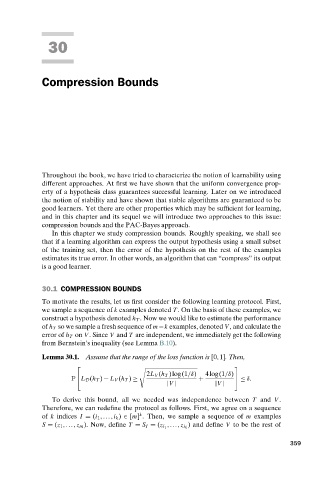Page 377 - Understanding Machine Learning
P. 377
30
Compression Bounds
Throughout the book, we have tried to characterize the notion of learnability using
different approaches. At first we have shown that the uniform convergence prop-
erty of a hypothesis class guarantees successful learning. Later on we introduced
the notion of stability and have shown that stable algorithms are guaranteed to be
good learners. Yet there are other properties which may be sufficient for learning,
and in this chapter and its sequel we will introduce two approaches to this issue:
compression bounds and the PAC-Bayes approach.
In this chapter we study compression bounds. Roughly speaking, we shall see
that if a learning algorithm can express the output hypothesis using a small subset
of the training set, then the error of the hypothesis on the rest of the examples
estimates its true error. In other words, an algorithm that can “compress” its output
is a good learner.
30.1 COMPRESSION BOUNDS
To motivate the results, let us first consider the following learning protocol. First,
we sample a sequence of k examples denoted T . On the basis of these examples, we
construct a hypothesis denoted h T . Now we would like to estimate the performance
of h T so we sample a fresh sequence of m −k examples, denoted V, and calculate the
error of h T on V.Since V and T are independent, we immediately get the following
from Bernstein’s inequality (see Lemma B.10).
Lemma 30.1. Assume that the range of the loss function is [0,1]. Then,
*
2L V (h T )log(1/δ) 4log(1/δ)
P L D (h T ) − L V (h T ) ≥ + ≤ δ.
|V | |V|
To derive this bound, all we needed was independence between T and V .
Therefore, we can redefine the protocol as follows. First, we agree on a sequence
k
of k indices I = (i 1 ,...,i k ) ∈ [m] . Then, we sample a sequence of m examples
) and define V to be the rest of
S = (z 1 ,...,z m ). Now, define T = S I = (z i 1 ,...,z i k
359

